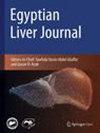Systolic and diastolic impairment in cirrhotic cardiomyopathy: insights from a cross-sectional study
IF 0.7
Q4 GASTROENTEROLOGY & HEPATOLOGY
引用次数: 0
Abstract
Cirrhotic cardiomyopathy, an intricate and multifaceted complication of end-stage liver disease, manifests as systolic and diastolic dysfunction in patients without previously diagnosed cardiac disease. Our study aims to investigate the prevalence of systolic and diastolic function in patients with cirrhotic cardiomyopathy in our region. We conducted a cross-sectional study on 68 patients with established cirrhosis, and no overt cardiac manifestations, who consequently underwent 2D echocardiography to quantify systolic and diastolic dysfunction, as defined by the 2019 Cirrhotic Cardiomyopathy Consortium. The severity of cirrhosis was determined using various validated scoring systems. A total of 19 out of 68 (28%) had systolic dysfunction, while 6/68 (9%) had evidence of diastolic dysfunction. Overall prevalence of cirrhotic cardiomyopathy was 23/68 (34%), and the presence of hepatitis C was strongly associated with systolic dysfunction with p-value of 0.007. However, it was not significantly associated with diastolic dysfunction, p-value = 0.59. Logistic regression analysis did not show any significant association between cardiac dysfunction and the severity of liver cirrhosis, as assessed by Child–Pugh, MELD, ALBI, PALBI, portal hypertension, and FIB-4 score (R2 = 3.66, F (13, 39) = 1.33, p = 0.234). Our study reveals a remarkable prevalence of cirrhotic cardiomyopathy, which despite being a frequently occurring phenomenon often goes unrecognized. Lack of correlation with the severity of liver cirrhosis, based on currently available scoring system, suggests either a still poorly understood pathological mechanism or requires the development of a new validated reliable scoring system through multi-center longitudinal studies.肝硬化心肌病的收缩和舒张功能障碍:一项横断面研究的启示
肝硬化心肌病是终末期肝病的一种复杂而多方面的并发症,在既往未确诊心脏病的患者中表现为收缩和舒张功能障碍。我们的研究旨在调查本地区肝硬化心肌病患者收缩和舒张功能的患病率。我们对 68 名已确诊肝硬化但无明显心脏表现的患者进行了横断面研究,这些患者随后接受了二维超声心动图检查,以量化 2019 年肝硬化心肌病联盟所定义的收缩和舒张功能障碍。肝硬化的严重程度是通过各种有效的评分系统确定的。68人中共有19人(28%)存在收缩功能障碍,而68人中有6人(9%)存在舒张功能障碍。肝硬化心肌病的总体发病率为 23/68(34%),丙型肝炎与收缩功能障碍密切相关,P 值为 0.007。丙型肝炎与收缩功能障碍密切相关,p 值为 0.007,但与舒张功能障碍关系不大,p 值为 0.59。逻辑回归分析表明,心功能不全与肝硬化严重程度无明显关联,肝硬化严重程度由 Child-Pugh、MELD、ALBI、PALBI、门脉高压和 FIB-4 评分评估(R2 = 3.66,F (13, 39) = 1.33,P = 0.234)。我们的研究揭示了肝硬化心肌病的显著发病率,尽管这是一种经常发生的现象,但往往不被人们所认识。根据目前可用的评分系统,肝硬化心肌病与肝硬化的严重程度缺乏相关性,这表明病理机制尚不清楚,或者需要通过多中心纵向研究开发新的有效可靠的评分系统。
本文章由计算机程序翻译,如有差异,请以英文原文为准。
求助全文
约1分钟内获得全文
求助全文

 求助内容:
求助内容: 应助结果提醒方式:
应助结果提醒方式:


